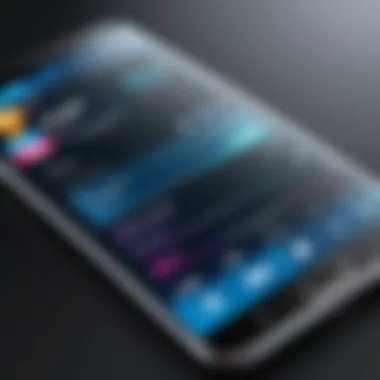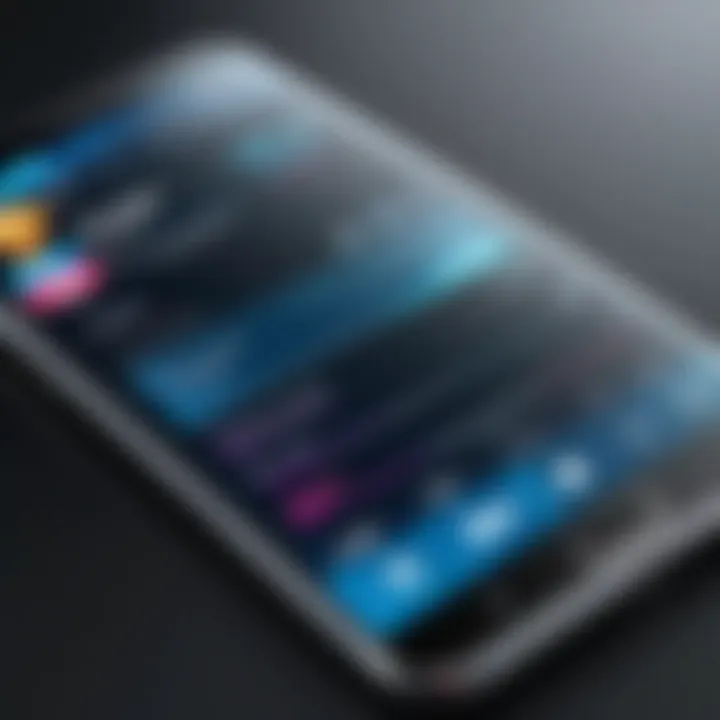Transforming Sounds into Unique Ringtones: A Guide


Intro
Personalizing your mobile device goes beyond just choosing the right wallpaper. Sounds play a crucial role in how we experience our gadgets. Ringtones are, without a doubt, one of the most impactful ways to express individual style. In a world where we are constantly bombarded by the same default sounds, having custom ringtones can make our devices truly feel like our own. This is not merely about vanity; it’s about creating an auditory identity that resonates with our preferences and emotions.
From the chirp of a bird to your favorite music track, transforming these sounds into ringtones allows users to elevate the mundane notifications of life into delightful auditory experiences. The beauty of modern technology lies in how accessible this process has become. Even those who might not consider themselves tech-savvy can delve into ringtones with relative ease. The following sections will unpack the nuts and bolts of this transformation, making it simple for anyone to get involved.
Let’s take a closer look at the tools and technologies that can assist us in this creative journey.
Prelims to Ringtones
In today’s digital age, ringtones serve as both a practical function and a creative expression. They are the sounds that announce an incoming call or message, but they can also reflect one's personality, style, and preferences. Creating custom ringtones allows individuals to stand out in the sea of generic tones that come with most mobile devices.
Understanding ringtones means not just knowing that they signal an incoming message but comprehending the wide range of sounds available—from snippets of your favorite song to quirky sound effects or a cherished voice message. The way these sounds integrate into our daily lives goes beyond mere utility; it reflects our individuality and cultural trends.
As people increasingly desire to customize their devices, the importance of personalization in ringtones has seen a notable uptick. Custom sounds evoke emotions, spark memories, and often create a sense of nostalgia. They also allow users to bring a distinct flair to their mobile devices, making even the mundane task of answering a phone call feel subjective and tailored.
When exploring the world of ringtone creation, one must also consider the implications of copyright and sound quality. Not every sound can legally be transformed into a ringtone willy-nilly; hence, it’s crucial to navigate these waters thoughtfully, understanding the rights associated with different sounds.
There’s no doubt that the journey of transforming simple sounds into personal ringtones is not only a creative endeavor but also a necessary skill in today's tech-savvy world.
Understanding Ringtones
Ringtones have evolved significantly over the years. Initially, they were simple beeps or single notes, designed simply to alert users to incoming calls. Today, they can capture full songs, sound bites from movies, or even customized voice recordings. Understanding ringtones involves grasping their technical aspects—like file formats (MP3, M4R, etc.)—as well as their cultural significance.
Different mobile operating systems also influence how ringtones are managed. For example, while iOS prefers M4R files, Android devices may accept a wider variety of formats. This variation can dictate how one approaches the ringtone creation process. The options are nearly limitless; from an upbeat piece that energizes you at work to a soft chime that helps create a calm environment in meetings.
Also, ringtones have become a form of art, where individuals curate not just playlists but specific audio snippets that evoke certain feelings or remind them of particular events. Often, people will associate particular sounds with significant moments in their lives—a graduation, a wedding, or even a casual hangout with friends.
The Importance of Customization
Customization of ringtones is essential in a world where personal identity matters to many—often, a ringtone is the first internet-based statement someone makes to the world. The ability to offset commonplace sounds with unique creations gives people the chance to infuse a bit of their identity into their devices. Apart from personalization, customized ringtones can greatly enhance the user experience.
- Expression of Identity: Ringtones are an extension of oneself, showcasing what one values. Whether it’s a favorite melody or a sound that sparks joy, picking a unique tone tells a story.
- Enhanced Functionality: Custom sounds can also serve functional purposes—different tones can signify different types of notifications. This means you wake up to a chill tune but might want a jazz number for work-related calls—they help to create distinct audio cues for various scenarios.
- Creativity: The act of creating a ringtone can be an exciting venture in itself. Many find joy in piecing together sounds, editing clips, or even composing original snippets. This not only showcases one's creativity but can sometimes be a therapeutic medium.
In sum, ringtones are far more than mere audio alerts; they’re opportunities for creative expression, cultural identity, and personalization. By deeply understanding ringtones, one can craft an experience on their device that resonates intimately with who they are.
Types of Sounds for Ringtones
The world of ringtones has evolved a lot over the years. No longer do we have to settle for those bland factory settings that come pre-installed on our phones. This section emphasizes the importance of understanding the different types of sounds that can be transformed into ringtones. Choosing the right type can elevate a typical mobile experience to something personal and distinctive.
When deciding on the sounds you want for your ringtone, consider how each type reflects your personality. Some people prefer upbeat tunes, while others might go for something quirky or even profound. Additionally, understanding the nuances of each type will help you make informed choices when creating your custom audio.
Music Clips
Music clips serve as one of the most popular choices for personalizing ringtones. They can be snippets from your favorite song or even catchy jingles that resonate with you. Here are some aspects to think about:
- Length and Selection: Most people tend to choose a section of a song that has strong musical hooks. Generally, a clip that’s about 20-30 seconds works well.
- Personal Connection: The deeper your connection to the music, the more it enhances your phone usage. A snippet from your wedding song or a track from a road trip might stir emotional memories every time the phone rings.
- Recognizability: Selecting a well-known melody can make it easier for those around you to identify that it's your phone ringing.
Sound Effects
Sound effects may not have the same emotional pull as music clips, but they add a playful dimension to your ringtone collection. Think of those cheeky sounds from cartoons or the classic beep of electronic devices. Here are some benefits of utilizing sound effects:
- Uniqueness: Because they're less used compared to music clips, sound effects can set you apart. A friend once made their ringtone a whimsical pop sound when they received a message. It sparked many laughs.
- Seasonal or Thematic Effects: You can also switch things based on the season or occasion. For example, a jingle bell sound during the holidays might bring a smile.
- Functional Cues: Some people utilize sound effects that convey specific moods or reminders—like a swoosh for notifications pertaining to fitness activities or reminders.
Voice Recordings
Voice recordings are another unique category. Rather than abstract sounds or music, they inject a human element into your ringtone. Here’s why you might consider this option:
- Personal Touch: A message or a phrase recorded by a loved one can be deeply touching, turning each ring into a warm reminder.
- Creative Possibilities: You could even get creative. How about recording a witty quip or motivational phrase that offers encouragement while you’re going through a busy day?
- Practical Use: With voice messages, the content can be tailored to be information-oriented, like reminders for important tasks or events.
Necessary Tools for Creating Ringtones
Creating a custom ringtone isn't just a fun project; it's an expression of identity. Selecting the right tools to assist you in this endeavor is crucial. Whether you're a novice or someone with considerable experience, having the proper software and hardware can make or break your ringtone-making journey. These tools provide the utility and flexibility necessary to craft sounds that resonate personally, transforming the mundane act of choosing a ringtone into a customizable experience.
Software Options
Desktop Applications
Desktop applications for ringtone creation stand out for their depth of features and user control. Programs like Audacity or GarageBand provide robust platforms for audio editing. Their key characteristic is the comprehensive toolset that allows fine-tuning like no other. You can manipulate audio files in intricate ways—cutting, fading, and even layering sounds. This flexibility makes it a favored choice for serious hobbyists or professionals aiming for perfection.
One unique feature of desktop applications is multi-track editing. This capability lets users combine sounds from different sources seamlessly. The disadvantage, however, lies in the learning curve; such programs might be overwhelming for beginners. Yet, once the basics are grasped, the rewards are significant.
Mobile Apps
In contrast, mobile apps, like Ringtone Maker or Zedge, cater to a different crowd. They are designed for accessibility and convenience. The primary benefit is immediacy—users can create ringtones on-the-go using their mobile devices. These apps emphasize user-friendliness, often featuring simple interfaces that guide users through making their ringtones with ease.
The unique aspect of these apps is the ability to utilize your library of songs or sounds directly from your phone. However, there may be limitations regarding editing capabilities compared to desktop software. For someone looking for quick and functional options, these apps deliver without getting bogged down in technicalities.


Online Platforms
Web-based Converters
Web-based converters emerge as an appealing alternative for those who prefer a no-download solution. Tools like Zamzar or Online Audio Converter allow users to upload audio files and convert them to formats suitable for ringtones quickly. Their key characteristic? Convenience. Users can access these platforms from any browser without installing software, which suits casual ringer creators.
One major advantage of web-based converters is they often support multiple audio formats. The restrictions usually come in the form of file size limits or potential upload speeds based on your internet connection. Nevertheless, for many, the ease of turning an audio file into a ringtone anywhere is well worth it.
Audio Editing Tools
Audio editing tools found online also play a crucial role in ringtone creation. Platforms such as AudioTool or TwistedWave allow users to edit files directly in their browser. The highlight here is the range of effects and options that can be applied without the need for downloads. The learning curve is moderate, but many tools offer templates to guide newbies.
Their disadvantage often lies in their dependency on stable internet connections, which can be a hassle if the connection falters mid-editing. Still, for a tech-savvy user who values rapid access and online collaboration, these tools are invaluable.
Hardware Requirements
While software options are paramount, hardware shouldn’t be neglected. A good audio interface can drastically improve sound quality when connecting external mics or instruments. Additionally, a pair of decent headphones is essential for precise audio editing. Investing in good quality hardware can significantly impact the clarity and fidelity of your final product, setting the stage for producing ringtones that sound professional.
Step-by-Step Process of Making a Ringtone
Creating a personal ringtone isn’t just about sounding nice; it’s an expression of individuality. The step-by-step process of making one breaks down the intricate details into manageable chunks, which makes it easier for anyone to follow. It’s like baking a cake: you gather your ingredients, follow a recipe, and in the end, you have something uniquely yours. Knowing the nuances of each step ensures that your final product is not only enjoyable but also fits well with your device formats and specifications.
Selecting Your Sound
The first step in crafting a ringtone is selecting the sound you desire. This includes identifying a piece of music, a particular sound effect, or even your own voice recording. Choosing the right sound is fundamental. It should speak to you, capture your mood, or reflect a milestone in your life.
Think of it like finding the perfect outfit for an important occasion. The sound should complement your personality and make you feel good when someone calls.
Cutting and Editing Audio
Now that you've tapped into your audio, it’s time to slice and dice! Cutting and editing the audio is crucial. You’ll want to grab just the right section of your selected sound, ensuring that it’s not too short to be recognizable and not too long to be annoying.
Trimming the Sound
Trimming the sound is a vital aspect of the editing process. This step enables you to cut out unwanted sections, usually the beginning or end where there might be silence or less important audio.
The beauty of trimming is its ability to refine your selection, so it focuses on the most engaging bits. It’s often seen as a popular choice in this realm. You want that catchy chorus or impactful sound byte rather than the entire song. The unique feature here is precision; trimming allows you to distill the essence of the audio into a concise snippet. On the downside, a beginner may find it tricky to decide when to cut or what to leave in, possibly resulting in lost memories or favorite parts of the sound.
Adjusting Volume Levels
After trimming, adjusting volume levels is the next logical step. This ensures that your ringtone isn’t blasting out everyone’s earbuds when on full volume or barely audible when left low.
This step has a clear and distinct purpose: making sure your ringtone sounds great on your device and is easily recognizable amidst background noise. The versatility in adjusting volume makes it a favorable option as it caters to different needs—loud environments or quiet settings. However, get it wrong, and you risk the frustration of a ringtone that could wake the dead or one that gets lost in the cacophony of daily life.
Exporting the Ringtone
Once the audio is polished, exporting is the next important phase. This step is about saving your creation in the right formats that your device can use. Not all devices support every format, so this is where a little knowledge goes a long way.
File Formats
When it comes to file formats, understanding the difference can be a lifesaver. Formats like MP3 or M4R are widely accepted across most devices. The key characteristic of selecting the right format is compatibility. Opting for a recognized format means fewer headaches later on down the line.
However, if you get too wrapped up in specific requirements, you might find your creation lost to incompatibility. Choosing wisely is your safeguard against heartache.
Saving Best Practices
Finally, saving your ringtone with best practices in mind is essential. Always save your work in a designated folder, ensuring it’s labeled correctly so you can find it easily. This reduces the headache of searching through heaps of files later on.
Best practices extend your creation’s lifespan. Ensure to keep backups, just in case life throws a curveball. Saving beneficially reduces the worry of accidental deletion or loss during transfers. This way, you can keep that one sound you just love forever.
Remember: Crafting a unique ringtone is more than just a technical task; it's a reflection of your taste, style, and creativity.
In summary, the step-by-step process of making a ringtone empowers users to take control of their auditory identity. Whether it’s through careful selection, meticulous editing, or understanding the technical aspects of exporting, each step plays a vital role in the final outcome.
Transferring Ringtones to Your Device
Transferring ringtones to your device is the bridge between creation and personalization. After taking the time to design the perfect ringtone that reflects your style, the next step is ensuring it properly lands on your phone. This section will dive into various methods for making this transfer seamless, which is essential for enhancing your mobile experience with that special touch. Each method has its perks, whether it’s instantaneous transfers or the convenience of cloud solutions, so it's worth considering what suits your lifestyle best.
Using USB Connections
One of the most straightforward methods to get your custom ringtone onto your mobile device is through USB connections. It’s akin to having a direct line—a very reliable one, mind you. Here’s how this works:
- Connect Your Device: Plug your phone into your computer using a USB cable. Most devices will prompt a mode selection; ensure that you select the option that allows file transfers.
- Locate Your Ringtone: Find the folder where you've saved your new ringtone on your computer. Usually, this is within the "Music" or a dedicated "Ringtones" folder.
- Transfer the File: Drag and drop the ringtone file into the appropriate folder in your mobile device. More often than not, devices recognize a specific folder for ringtones, typically named "Ringtones".
- Eject Properly: Always eject your device safely from your computer to avoid any data corruption.
Using USB has that old-school reliability; it allows for high-quality transfers without the potential issues that sometimes come with wireless connections. However, it does mean you need your computer nearby, which can be a hassle if you’re on the go.
Bluetooth Transfers
Bluetooth offers a very accessible option for transferring ringtones, especially handy in situations when a data cable becomes MIA. This method is wireless, which means you can share sounds from anywhere within Bluetooth range. To make this work:
- Turn on Bluetooth: Ensure the Bluetooth options are enabled on both your sending and receiving devices.
- Pair the Devices: Depending on your devices, you may need to pair them first. Usually, this entails searching for devices on one and confirming a connection on the other.
- Send the Ringtone: Once paired, locate the ringtone file on the sending device. Select it, choose the option to share via Bluetooth, and select your receiving device from the list.
- Accept the File: Finally, accept the incoming file on your mobile device to complete the transfer.
Bluetooth transfers offer flexibility and convenience, especially when you don’t have hardware right on hand. Just keep in mind that the transfer speed can be slower than USB, which can be noticeable if you’re sending larger files.
Cloud Services Integration
Cloud services have become commonplace in our digital lives. They not only provide storage but also make transferring your custom ringtones easier. Utilizing platforms like Google Drive or Dropbox can be beneficial.
- Upload to the Cloud: Save your ringtone to a cloud service. Open the app on your computer or mobile device and upload the file just like you would for any other document.
- Access the File: On your mobile device, open the cloud service app. You’ll be able to find the ringtone saved in the cloud.
- Download the File: Tap on the file and select the download option, which pulls the ringtone onto your device itself.
- Set as Ringtone: Once downloaded, navigate to your device's sound settings to set the new ringtone.


Cloud services eliminate the need for physical connections and avoid potential technical issues associated with traditional transfers. They also give you access to your ringtones from anywhere, improving convenience.
Remember: Before using cloud services for ringtone transfer, check the storage limits of your plan. Some services have restrictions that could prevent you from uploading larger files.
In summary, whether you sway towards USB connections, prefer the flexibility of Bluetooth, or relish the cloud’s convenience, transferring your ringtones opens a gateway for personal expression. Don't shy away from exploring these options to find what fits best in your life.
Setting Up Your Ringtone on Mobile Devices
Setting up your ringtone on mobile devices is a critical aspect of personalizing your smartphone experience. The sounds that alert you to calls or messages can have a significant impact on how you interact with your device and how others perceive your style. With options ranging from built-in sounds to custom creations, knowing how to properly set up ringtones not only enhances your user experience but also reflects your individuality.
Custom ringtones allow users to express themselves and stand out in a sea of standard notifications. With families, friends, and colleagues frequently reaching out, you can differentiate who’s calling with a mere sound rather than instinctively checking the screen. Additionally, a customized ringtone can even influence social settings—imagine having a familiar tune play during a gathering that sparks conversation or nostalgia. Not to mention, being aware of the technicalities behind ringtone setup can save you from embarrassing moments, such as missing important calls while your phone is on silent, specifically during events.
iOS Devices
Using iOS devices, setting up ringtones is generally user-friendly yet involves a few specific steps to ensure optimal results. Here’s how you might go about it:
- Using iTunes to Sync: If you have your ringtone ready as a file, use iTunes to sync it to your device. Import the audio file into your iTunes library, then connect your iPhone. In the device summary page, check the "Tones" box and sync.
- Directly on iPhone: For those who prefer a simpler route, you can create a ringtone directly on your iPhone using GarageBand. This app allows you to start from scratch or import audio from your library easily. After editing your sound, simply export it directly as a ringtone.
- Setting the Ringtone: Once you have the ringtone on your phone, navigate to Settings > Sounds & Haptics > Ringtone, and choose your new sound from the list available. This can be a straightforward path, but sometimes complications arise, especially with file formats directly affecting compatibility.
It’s worth keeping in mind that iOS typically prefers files that are in the M4A format, so make sure to convert your audio files accordingly. A little attention to detail can go a long way.
Android Devices
For Android users, setting up a custom ringtone might feel slightly different across various devices due to manufacturer-specific interfaces, but the essence remains the same. Here’s what you can do:
- File Management: First, ensure that your audio file is in a format supported by your device, usually MP3 or OGG files. Next, transfer the ringtone file into the appropriate folder on your device, often located in the "Ringtones" folder in your internal storage or SD card.
- Using Sound Picker: Most Android devices come equipped with a sound picker. To set the custom tone, go to Settings > Sound > Phone Ringtone. Here, you will find an option to add your audio to the list, allowing you to select your desired sound easily.
- Using Apps for Assistance: If you prefer a more guided experience, numerous apps in the Google Play Store can provide step-by-step instructions. These apps often help trim audio files or convert them, ensuring an easier process overall.
Troubleshooting Common Issues
When it comes to crafting your own ringtones, there's a good chance you may encounter some bumps along the way. Navigating through these difficulties is crucial since they can spoil the satisfaction of hearing your customized sound. Understanding common problems and their solutions makes the process smoother and gives you the confidence to dive deep into ringtone creation.
File Compatibility Problems
One of the most frequent headaches people face is file compatibility. Imagine dedicating time to clip the perfect sound, only to find out that your smartphone doesn't support it. This can lead to frustration, especially when you’re excited to set your new ringtone.
Most devices work with specific formats like MP3, M4A, or WAV. If your chosen file type doesn’t match what your phone can handle, you're stuck—either scrambling to convert it or outright abandoning the clip. Here's a basic rundown of the formats:
- MP3: Universally accepted across most devices and straightforward for sharing.
- M4A: This format provides better sound quality while still keeping file size manageable. It’s favored by Apple products.
- WAV: Offers high-quality audio, but files are usually larger, making them less convenient for mobile use.
To avoid these confusions:
- Double-check your device's specifications for supported formats.
- Use audio editing software that allows for easy conversion to your desired type. There are several online resources that facilitate this.
"Prevention is better than cure." - Knowing the compatible formats beforehand can save you a lot of headaches.
Audio Quality Concerns
Once you are past the compatibility hurdle, you might encounter audio quality issues. After all, no one wants a ringtone that sounds grainy or inconsistent. Factors like bitrate and sampling rate factor heavily into how good your custom sound will be.
Common audio quality problems include:
- Low Bitrate: This can lead to a muffled or tinny sound. A bitrate of at least 192 kbps is advisable for decent audio quality.
- Clipping: If a sound is too loud, it can distort. Make sure to adjust the volume levels while trimming your audio.
- Background Noise: Sounds that are too noisy or hasty in editing can detract from the experience. Always ensure you're working with clear audio files and use noise-reduction techniques if necessary.
To ensure top-notch audio quality:
- Utilize a good audio editor that can help adjust these parameters effectively.
- Test your ringtone on different devices post-export to ensure it sounds great everywhere.
By anticipating these common troubles, you can approach ringtone creation with a clearer understanding and enhance your overall mobile experience with unique tunes tailored to you.
Exploring Alternatives to Traditional Ringtone Creation
When it comes to creating ringtones, many of us picture the familiar route of editing a favorite music clip or sound byte. However, digging deeper into alternatives offers valuable and unique insights into how we can achieve even more personalization. The world of ringtone creation is vast and often expanding, allowing individuals to express their identity more uniquely than just conventional approaches.
By exploring alternatives, individuals can tap into a wealth of ready-made resources and innovative technology, reducing the time and effort required to craft the perfect ringtone. This exploration isn’t just a matter of convenience; it enriches one’s mobile experience, making it more aligned with personal tastes and preferences.
Using Pre-Made Ringtone Libraries
For those who prefer simplicity or may not have the time or skills to create their own ringtones, pre-made ringtone libraries can be a godsend. These libraries often boast extensive collections spanning various genres, moods, and styles, enabling users to find that perfect sound with just a few clicks. Such platforms typically offer audio files that are already formatted for use on smartphones, eliminating potential issues that arise from file compatibility in traditional methods.
Benefits of Pre-Made Libraries:
- Wide Variety: From pop hits to classic tunes, there’s often something for everyone.
- Time-Saving: No need to spend hours editing; simply download and set it.
- Quality Assurance: Many libraries provide high-quality sound, ensuring your ringtone stands out.
While it's easy to stick to the popular choices, stepping out of that comfort zone and browsing the library may unveil some hidden gems. Just think of the thrill of hearing an obscure track everyone's forgotten about ring on your phone.
Sound Sampling from Apps
Another emerging alternative is sound sampling from apps. Mobile applications have been tailored to enable users to create ringtones from virtually any sound they encounter daily. This could range from a child’s laughter to the ambiance of a bustling café. Live sampling apps can pick up and format these sounds on-the-go, turning mundane moments into delightful ringtone material.


Key Considerations when Using Sound Sampling:
- User-Friendly Interfaces: Many sampling apps are designed for ease of use, even for those who may not consider themselves tech-savvy.
- Creative Freedom: There's no limit to what sounds can be used. Users can get truly original in crafting their ringtones.
- Immediate Engagement: Need a ringtone in a pinch? Snap it! You can have material ready within moments.
Incorporating sound samples opens doors to uniquely personal ringtones, transforming everyday sounds into audio files that resonate with individuals.
"The journey to creating a unique ringtone is as intriguing as the sounds themselves, revealing insights into personal experiences and aesthetics.”
By exploiting alternatives like pre-made libraries and sound sampling, users not only streamline the process of crafting ringtones but also enhance their devices with audible reflections of their own lives. Experimenting beyond the usual methods can lead to finding that perfect sound that aligns with not just one’s taste in music but also personal moments captured through sound.
Legal Considerations in Ringtone Creation
When it comes to crafting personalized ringtones, one must not overlook the legal landscape that governs the use of sound in our devices. Navigating this terrain is crucial not just for artists and creators, but also for everyday users who want to avoid unexpected issues down the line. There’s a lot more at play here than just picking your favorite sound and slapping it on your phone.
In an age where audio sharing is virtually effortless, understanding the importance of copyright and licensing can save you from legal headaches. If you're hesitant about whether your custom creation could unintentionally step on someone's toes, keep reading.
Copyright Issues
Copyright law is like a protective shield for creators. It gives the original artists control over how their work is used—this includes music tracks, sound bites, and even specific audio arrangements. The echo of a catchy tune may resonate with you, but remember, it may belong to someone else.
Here are a few key points to keep in mind regarding copyright:
- Artistic Ownership: You don’t just have free rein over any audio you stumble upon. Artists, composers, and sound designers own the rights to their creations.
- Format Matters: Even a 10-second clip can be copyrighted. Just because you’re not using the whole piece doesn’t mean you’re in the clear.
- Consequences of Infringement: Using copyrighted material without permission can lead to legal consequences, including hefty fines and removal of your ringtone.
For those who are inclined to use popular music or sounds, turning to royalty-free or public domain resources can ease these concerns. As always, when in doubt, check the source.
Licensing Requirements
While copyright addresses who owns the audio, licensing dives deeper into how that audio can be used. Licensing acts as a binding agreement between the creator and the user, often detailing permissions and restrictions. For ringtone creators, understanding these licensing elements is crucial to avoid crossing any legal lines.
Here are some of the key aspects of licensing you should be aware of:
- Types of Licenses:
- Get Written Permission: If you plan to use copyrighted material, obtaining proper licensing can clear the air. An email or agreement from the copyright holder can go a long way.
- Stay Updated: Laws around copyright and licensing can shift rapidly. Regularly following sites like Wikipedia and Britannica can provide guidance on what’s acceptable and what’s not.
- Royalty-Free Licenses: Allow for limited uses without paying royalties on each use, often a great route for creators.
- Creative Commons Licenses: Let you use certain works for free, but often require attribution to the original creator.
In summary, while the process of creating ringtones can be a delightful experience, ensure you’re on the right side of the law. After all, you wouldn’t want a catchy melody ringing in your pocket while a legal storm brews overhead.
"The beauty of sound lies not just in its emotive power but also in the respect we owe its creators."
By understanding copyright and licensing, you're not only protecting yourself but also honoring the artistry behind the sounds you love.
Future Trends in Ringtone Customization
The landscape of ringtone customization is evolving at a rapid pace, much like the tech world it inhabits. As mobile devices continue to merge seamlessly into our daily lives, the demand for unique personalization grows. This section explores upcoming trends that are shaping how we think about and create ringtones, focusing particularly on the integration with smart devices and the role of artificial intelligence.
Integration with Smart Devices
The rise of the Internet of Things (IoT) has made it possible for ringtones to transcend the confines of mobile phones. Many modern households now feature smart devices that not only play music but can also ring in response to notifications from smartphones. This integration brings a new dimension to the idea of a ringtone.
- Smart speakers and home assistants can be programmed to recognize different contacts and respond with specific tunes. Imagine your Google Home chiming a favorite tune when your best friend calls while your Amazon Echo plays a totally different sound for your boss. This not only enhances user experience but also personalizes the home environment significantly.
- Connected wearables like smartwatches are also jumping on the bandwagon. Historically, these devices had only basic alert tones, but advancements allow users to select custom sounds directly from their music libraries. This means that your Apple Watch could sport a light-hearted jingle for your messages while keeping serious tones for important calls.
The implications are vast. As smart devices proliferate, the ability to control how different alerts sound based on context will no doubt appeal to a tech-savvy audience. It’s about creating an atmosphere that fits, right down to the sound it produces.
Artificial Intelligence in Sound Creation
Stepping into the future, artificial intelligence is becoming an essential player in the realm of ringtone creation. AI's capability to analyze and learn from existing data opens doors to sophisticated audio customization methods. Here’s how:
- Personalization through Machine Learning: AI can tailor ringtones based on user behavior. For example, if a user frequently receives calls during workout sessions, an upbeat and energizing sound can be suggested by the AI. Over time, as it gathers more data, the sound recommendations become increasingly accurate.
- Generative Sound Design: There are already applications utilizing AI to create original sounds. Instead of relying on pre-recorded clips, users can now generate unique ringtones that reflect their tastes. Tools like OpenAI’s MuseNet can compose music based on user inputs or selected genres. This innovation is set to democratize music creation, making it easier for individuals without formal training to craft their personal soundtrack.
- Adaptive Audio Technology: With advancements in AI, the possibility of adaptive audio comes into play. This means sounds will dynamically change depending on the time of day or the user’s activity. For example, as you transition from work mode to relaxation in the evening, the ringtone could tone down into something more soothing.
"As we blend personalization with technology, the future of ringtone customization could allow our devices to know us better than we know ourselves."
As these technologies develop, they promise to make customization not just an option, but an experience that evolves with the individual. The convergence of smart devices and AI is set to redefine what a ringtone means, moving it beyond a mere alert and into the realm of personal expression.
In summary, keeping an eye on these trends isn’t just for the gadget lovers; it's for anyone looking to make their mobile experience more uniquely theirs. As creators and consumers alike, we ought to embrace these changes and explore the endless possibilities they present.
Culmination
In summary, the process of transforming sounds into ringtones stands as an essential skill in today’s audio-centric world. This exploration has illuminated several crucial aspects, such as the variety of sounds one can use, the tools available for creation, and the vital steps involved in transferring and setting up those sounds. Custom ringtones serve not just a functional purpose; they also reflect personal preferences and identity. By incorporating unique audio snippets, individuals can distinguish themselves in a crowded digital landscape.
Recap of Key Points
To reinforce the knowledge acquired in this guide, let’s briefly recap:
- Understanding Ringtones: Recognizing ringtones as a means of personalization adds an extra layer of functionality to our devices.
- Types of Sounds: Ringtones don't only come from music but can also be derived from sound effects or voice recordings, expanding choices significantly.
- Necessary Tools: Various software, apps, and online platforms cater to those who might not be deeply tech-savvy, ensuring accessibility to everyone.
- Transferring Methods: Knowledge of USB, Bluetooth, and cloud-based solutions helps with seamless ringtone transfers.
- Legal Concerns: Ensuring compliance with copyright and licensing is crucial, preventing unnecessary legal troubles in the future.
- Future Trends: Innovations in smart devices and AI technology continue to unlock new avenues for customization, promising even greater ways to express oneself.
By understanding these key areas, readers are better equipped to venture into the realm of personalized audio.
Encouraging Personal Exploration
The ultimate goal of this comprehensive guide is to encourage individual creativity and exploration. Ringtone customization is more than just a technical endeavor; it's an artistic expression. For those feeling adventurous, experimenting with different audio sources can lead to the creation of truly unique ringtones. Whether it’s a favorite excerpt from a song, an ambient sound captured during travel, or a voice note, the potential is nearly limitless.
Exploring these possibilities not only enhances one's personal audio library but also results in richer interactions with technology. It’s about making devices feel more like an extension of oneself rather than just tools for communication.
In the end, personal expression through sound is as important as ever. Dive into this sonic adventure, and don’t hesitate to showcase your individuality in your everyday life! After all, who doesn't want a little piece of their personality ringing in their pocket?







